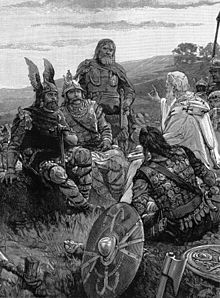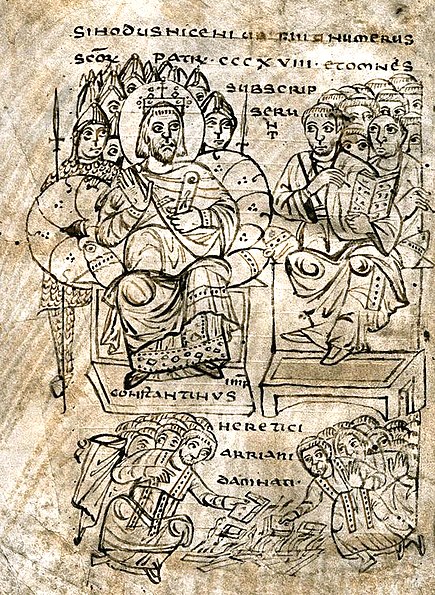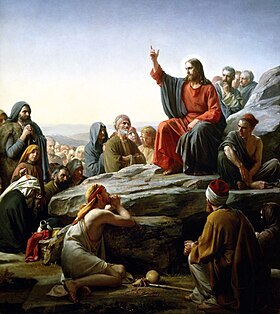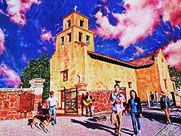Click here to return to 3) Rise of Byzantium, Orphaned West
Click here for more on this phenomenon at "Illiteracy and the Spread of Christianity"
Even after Constantine the Great burnt the Arian scriptures at the Council of Nicaea, his own son, Constantius II, would become an Arian follower, (ruling from 324 until 337 CE). Later, Emperor Valens, also of Arian belief, would rule as emperor (from 364 until 375 CE).
Both Ulfilas and Constantinius II were aware of the religious edicts of the Nicaea Council, yet both continued to follow their own Arianistic beliefs. Consequently, because of prolific missionary work, like that of Ulfilas, most of the known world developed Christian followings, even if not of Nicene accord. Moreover, to a very great degree, Western barbarians were becoming Arians while their Eastern Persians and Syrian-Egyptian counterparts turned towards Gnosticism.
There are polytheistic elements within the Gnostic sect that clearly predate Christian Gnosticism. And, unlike most Christian Sects, including Arianism (which simply questions the divinity and trinitarianism of the Christ), Christian Gnosticism is more of a polytheistic adaptation which employs Christian elements of the Gospels when they're able to work as synonomous interpretations. For example Christianity warns against the flesh and earthly possessions. Likewise, Gnostic beliefs consider mortal existence and even the earth itself to be impure, instructing chosen followers how to shed their mortal coil and become one with the divine. When comparing divinities "Monad" would be God the Father, "Sophia" (Wisdom) Jesus, and "Demiurge" Satan.
Nonetheless, with a continual influx of Persians into Greek Byzantium, Gnosticism was something to be dealt with by the early Christians (and was a source of considerable discussion at the Council of Nicaea). By comparison, it took on few, if any, roots in the Roman west. Its greatest following would be of Persian or Syrian-Egyptic ethnicity, far beyond the borders of the Empire. When compared to other Christian splinter groups, Gnosticism was exotic to an extreme. Corresponding precepts within the Moslem Quran would prove far closer to Christian canon.
Persian Christian Gnostic beliefs included Manichaeism, which date back to the self-anointed prophet Mani (216 - 276 CE), who is quoted as saying "The true God has nothing to do with the material world or cosmos". Mani was known to introduce himself as "...an apostle of Jesus Christ". He died a month after being arrested by order of Emperor Bahram I.
By comparison, Syrian-Egyptian Gnosticism is similar but depends more on apocrypha (secret gospels) which is today considerer apostolic pseudepigrapha (forgeries / falsely attributed). One of the more famous apocrypha would be the "Gospel of Thomas", where a sometimes untamed childhood of Christ is portrayed.
Author's Note: There were numerous Christian Sects during early Christianity, for the purposes of brevity and remaining on topic, only the two most influential sects (Arianism and Gnosticism) are discussed in this article.
Consequences and Influences
Constantine had made it clear that a divided religion equaled a nation divided. Whether imagined or contrived, he managed to pull his troops together with his saintly vision of the cross and the application of the Chi Rho to his soldiers shields. He eliminated persecution of Christians with the Edict of Milan and made a visible spectacle of burning Gnostic and Arian scriptures during the Council of Nicaea. Still insufficient, Emperor Theodosius I would later make Christianity the empire’s state religion with the Edict of Thessalonica.
Subsequently the sin of heresy, a condition unique to monotheism, would grow to become the greatest sin under church law. It would eventually be punishable by torture and death for all that challenged Church Canon. It became a source of civil war (Montesquieu: "No kingdom has ever had as many civil wars as the kingdom of Christ." (Persian Letters, 1721), and the Christian Crusades against "Muslims, pagan, heretics and peoples under ban of excommunication". Throughout the Middle Ages heretical purges would be issued by papal bull, eventually resulting in multiple Holy Inquisitions.
Go to: Chapter 5) Western Renewal, Eastern Decline
Got Feedback?
Rogue Christian Sects
As previously sited (The Emperor's Faith: Part 1), in 325 CE the Council of Nicaea attempted to consolidate Christian belief to begin development of singular canon. However, that singularity would not be completed for centuries and only after considerable struggle and setbacks. Furthermore, the Western Latin and the Eastern Greek churches would subsequently prove to have more than just language differences. They would also spawn their own blends of rogue cults, usually far beyond the furthest reaches of the empire. Sectarian missionaries would embark with the best intentions, often times with the blessings of presiding bishops and, on at least one occasion, with the involvement of a supportive, like-minded emperor.
 |
| "Q" Sourced Synoptical Gospels |
Reasoning Behind Splintered Beliefs
Christianity did not start out with a written bible. In fact there was no a bible per se, or at least one the fathers of the church would agreed upon, until the middle ages. Instead, the Gospel first went out the door as Oral Tradition, creating what Hierographologist (scripture scholars) refer to today as the Q-Source. Imagine hundreds of zealots heading out in all directions with slightly different versions of their oral Gospel left behind at each stop on the way, to be told and retold by recent converts (with no formal training). If you have ever witnessed the metamorphoses of some gossip or a joke in just a few days, you can well imagine how these gospel tales became distorted over a few hundred years. Moreover, local myth and pagan beliefs would inevitably become intermingled to temper the story, making it easier to grasp for each new (pagan) audience. Consequently, due to these regional transmutations and language translations which eventually took place during any written transcription (often occurring centuries later), scholars today can’t even be certain about the Q-source. I suppose that’s where “faith” comes in.Click here for more on this phenomenon at "Illiteracy and the Spread of Christianity"
Western Arians
 |
| Constantius II |
 |
| Ulfilas Preaching to the Goths |
Arian missionary work would continue into and beyond the 4th century. Born in 310 CE, the zealot Ulfilas was a prime example of the hundreds of successful Arian missionaries trained in the tradition of Saint Paul. In 348 CE, after being persecuted by a barbarian lord in Nicomedia, just south of the Black Sea, he obtained permission from Emperor Constantius II, to migrate to what is today Bulgaria. A pious man, Ulfilas continued to convert barbarian Goths and Visigoths until his death in 383 CE Aside from his large number of conversions he is also know for his translation of the bible from Greek to Gothic, creating a version of the Getae alphabet in the process.
Both Ulfilas and Constantinius II were aware of the religious edicts of the Nicaea Council, yet both continued to follow their own Arianistic beliefs. Consequently, because of prolific missionary work, like that of Ulfilas, most of the known world developed Christian followings, even if not of Nicene accord. Moreover, to a very great degree, Western barbarians were becoming Arians while their Eastern Persians and Syrian-Egyptian counterparts turned towards Gnosticism.
Eastern Gnostics
 |
| Demiurge the Evil Entity |
Nonetheless, with a continual influx of Persians into Greek Byzantium, Gnosticism was something to be dealt with by the early Christians (and was a source of considerable discussion at the Council of Nicaea). By comparison, it took on few, if any, roots in the Roman west. Its greatest following would be of Persian or Syrian-Egyptic ethnicity, far beyond the borders of the Empire. When compared to other Christian splinter groups, Gnosticism was exotic to an extreme. Corresponding precepts within the Moslem Quran would prove far closer to Christian canon.
 |
| The Prophet Mani |
By comparison, Syrian-Egyptian Gnosticism is similar but depends more on apocrypha (secret gospels) which is today considerer apostolic pseudepigrapha (forgeries / falsely attributed). One of the more famous apocrypha would be the "Gospel of Thomas", where a sometimes untamed childhood of Christ is portrayed.
Author's Note: There were numerous Christian Sects during early Christianity, for the purposes of brevity and remaining on topic, only the two most influential sects (Arianism and Gnosticism) are discussed in this article.
Consequences and Influences
 |
| Constantine Burning Arian Books |
.jpg/220px-Pedro_Berruguete_-_Saint_Dominic_Presiding_over_an_Auto-da-fe_(1475).jpg) |
| Auto da Fe |
War, Schism and Purges
Nevertheless, two and three centuries later, heretical elements would still abound. Fringe conversions of Goths and Visigoths would lead to Arian rule in Western Latin provinces. As there was no positive trinitarian explanation set down in stone, sectarian differences would eventually influence both Latin and Greek churchs' theological views on the Trinity. This would become a doctrinal dispute that would differed but slightly, yet sufficiently enough to draw both sides closer towards the Great Schism of 1054.Subsequently the sin of heresy, a condition unique to monotheism, would grow to become the greatest sin under church law. It would eventually be punishable by torture and death for all that challenged Church Canon. It became a source of civil war (Montesquieu: "No kingdom has ever had as many civil wars as the kingdom of Christ." (Persian Letters, 1721), and the Christian Crusades against "Muslims, pagan, heretics and peoples under ban of excommunication". Throughout the Middle Ages heretical purges would be issued by papal bull, eventually resulting in multiple Holy Inquisitions.
 |
| Sermon on the Mount |
Commentary
One could ask "How could any of this have been derived from the Gospels?" It all seems a bit contrary to the Beatitudes. When Christ first cared for the poor and fed the hungry could any of his apostles have possibly imagined such chaos and division occurring so far off Christ's path? When Saint Paul argued with Saint Peter during the Incident at Antioch could they, in their wildest dreams, have foretold such derailing effects from pagan influences? Perhaps Jesus was spot on when he commanded his apostles “Do not go among the Gentiles...” [Matthew 10:5-42]".Go to: Chapter 5) Western Renewal, Eastern Decline
Got Feedback?
Comments? Questions? Corrections? Any feedback at all? Just click on the comments box at the bottom of this page and enter your thoughts. All comments are welcome.
Santuario de Guadalupe, the oil painting by Tom Mallon. This 42" x 22" canvas is the latest addition to the Santa Fe Portrait Series. The Santuario is the oldest shrine to Our Lady of Guadalupe in the US.
Visit this later update by CLICKING HERE
Shostakovich and Cultural Snobbery, Could anyone survive Stalin's Purges, compose a large body, write for himself and the masses while producing constantly great work?
Visit this later update by CLICKING HERE
Also of interest…
Tom Mallon's website "MallonArt". This website will provide you with links to all his paintings, drawings and other artwork portfolios, including the ongoing series entitled the Santa Fe Portrait.
Visit this later update by CLICKING HERE
Santuario de Guadalupe, the oil painting by Tom Mallon. This 42" x 22" canvas is the latest addition to the Santa Fe Portrait Series. The Santuario is the oldest shrine to Our Lady of Guadalupe in the US.
Visit this later update by CLICKING HERE
Shostakovich and Cultural Snobbery, Could anyone survive Stalin's Purges, compose a large body, write for himself and the masses while producing constantly great work?
Visit this later update by CLICKING HERE
Tom Mallon's website "MallonArt". This website will provide you with links to all his paintings, drawings and other artwork portfolios, including the ongoing series entitled the Santa Fe Portrait.
Visit this later update by CLICKING HERE




No comments:
Post a Comment